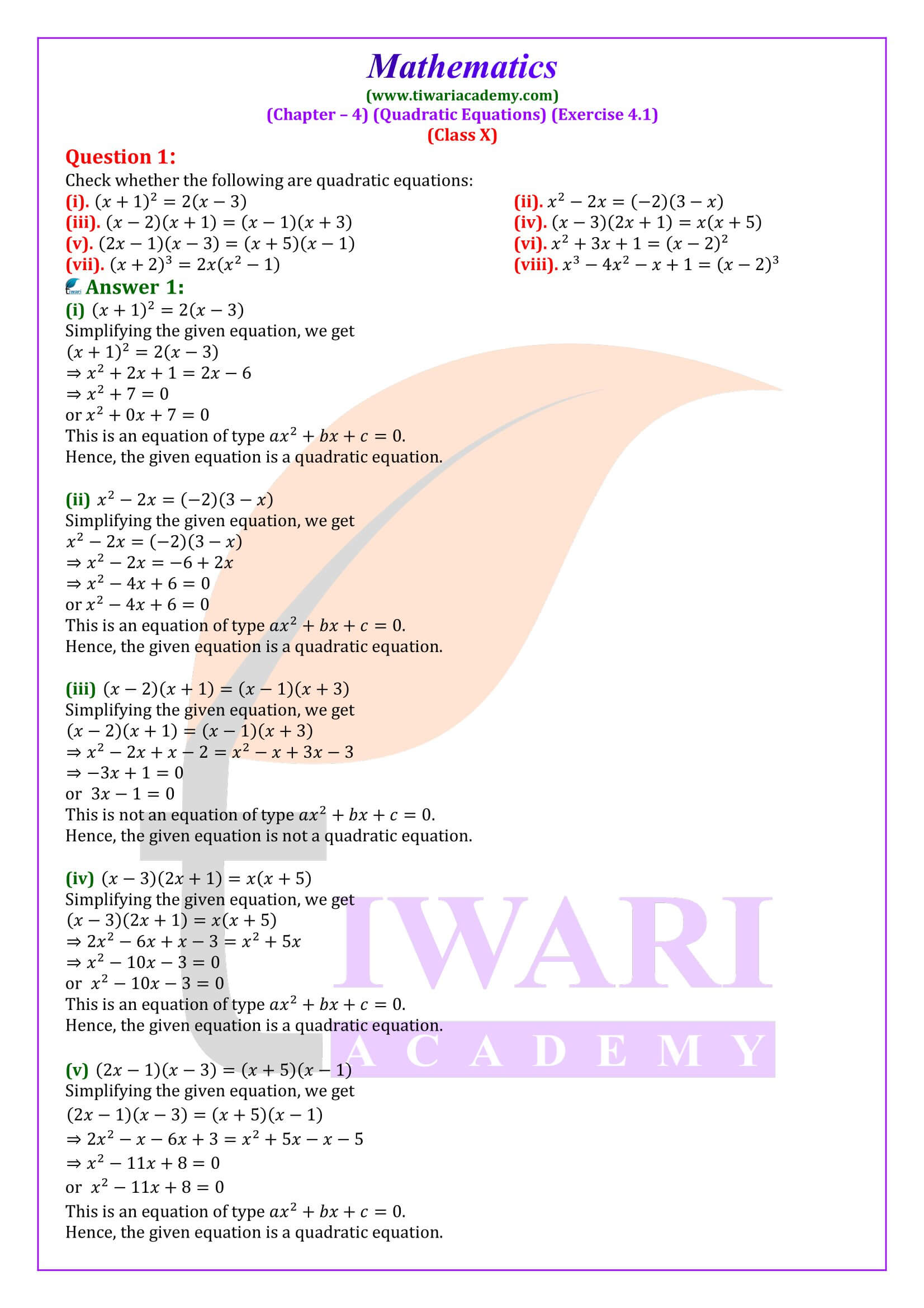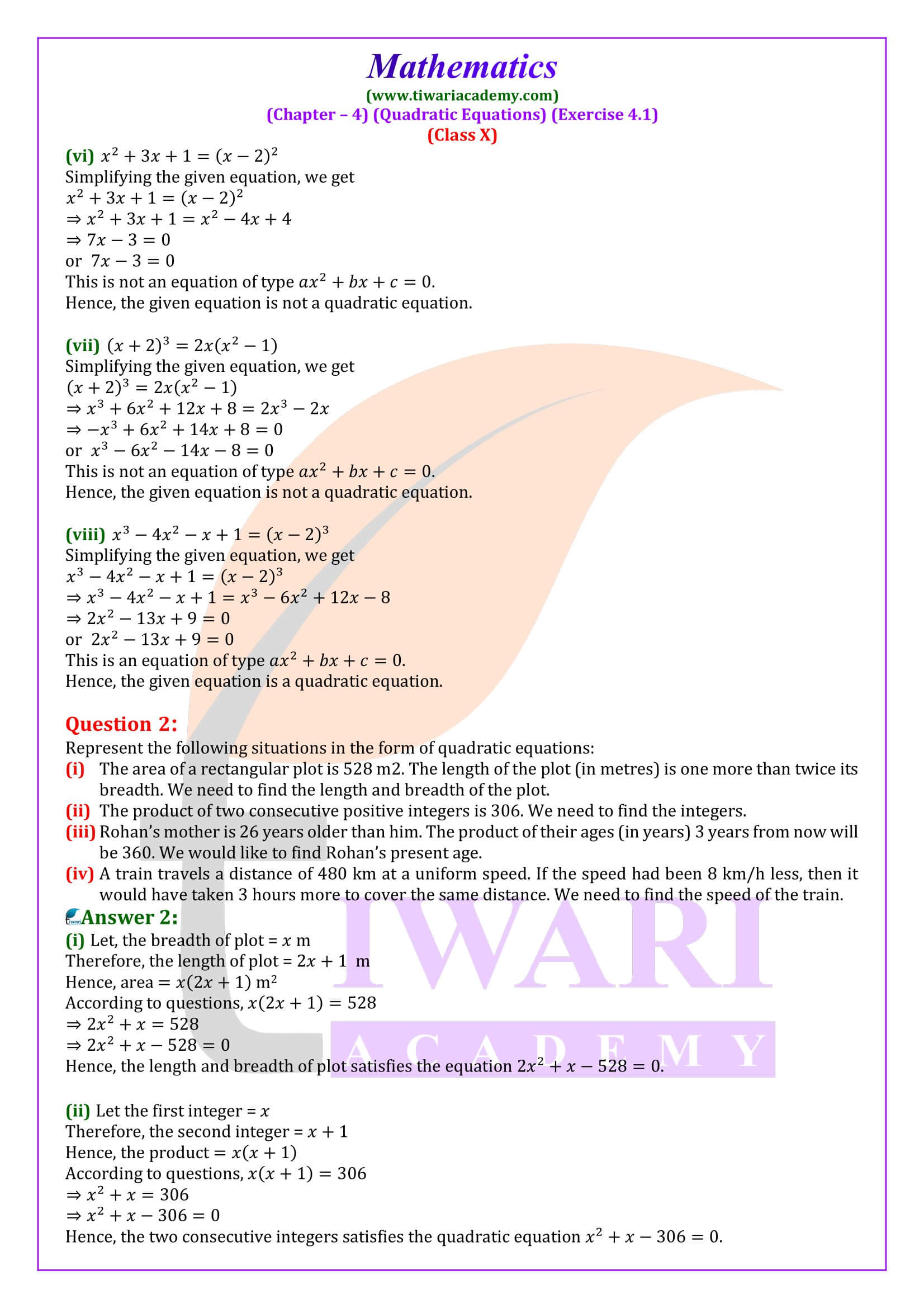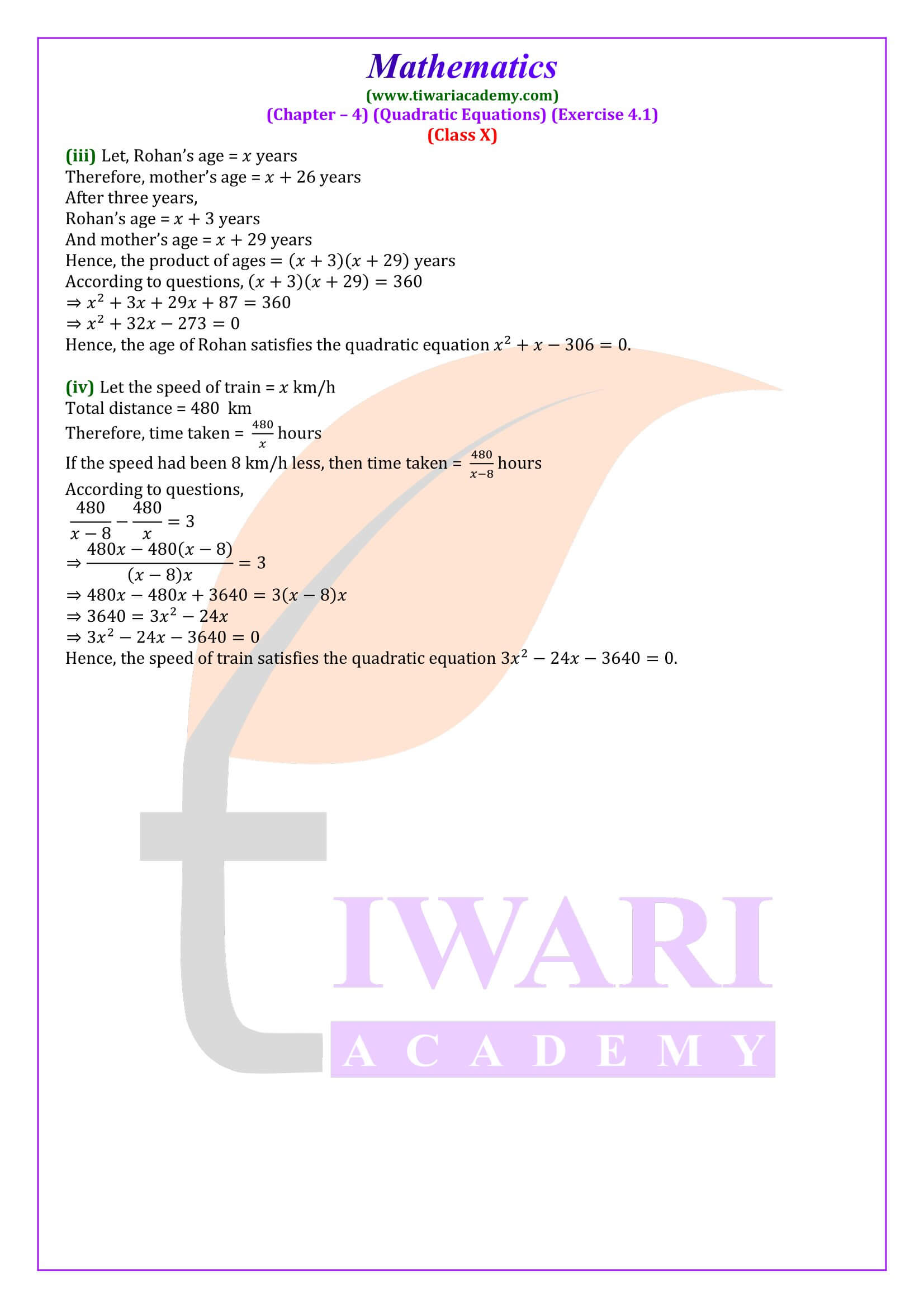NCERT Exercise 4.1 Solutions for Class 10 Maths Chapter 4 Quadratic Equations with Hindi and English Medium Updated for Session 2025-26. Textbook Revised Solutions for Exercise 4.1 of Class 10 Maths Chapter 4 have been modified as per the latest NCERT textbooks introduced for the 2025-26 board exams. Available in both Hindi and English medium, these solutions provide clear, step-by-step explanations to help students understand the foundational concepts of quadratic equations. Exercise 4.1 focuses on identifying and converting given equations into the standard quadratic form. With easy-to-follow methods and simplified explanations, these updated solutions aim to strengthen the basics, helping students gain confidence and accuracy in recognizing and expressing quadratic equations in the correct format.
NCERT Exercise 4.1 Solutions for Class 10 Maths
| Class: 10 | Mathematics |
| Chapter 4: | Exercise 4.1 |
| Contents: | Textbook Question Answers |
| Mode of Content: | Text, Images and Videos |
| Session: | CBSE 2025-26 |
| Medium: | English and Hindi Medium |
Class 10 Maths chapter 4 Exercise 4.1 Preparation
To prepare for Exercise 4.1, in Class 10 Maths, it’s crucial to focus on identifying quadratic equations. Start by thoroughly reviewing the different forms of equations presented, ensuring you understand the standard form of a quadratic equation. Pay attention to equations that might initially seem quadratic but aren’t, as simplification is often necessary. Practice recognising quadratic equations from real-life problems, which will help in quickly identifying them during exams. Ensure that you are comfortable with factoring, as this is essential for identifying whether the given expressions fit the quadratic format.
In the exam, problems in class 10 Maths exercise 4.1 will test your ability to recognize quadratic equations, so you should practice solving various problems and checking your answers. Make sure to work through example problems provided in the textbook to solidify your understanding. It is also helpful to work on timed quizzes to improve speed and accuracy in identifying and solving quadratic equations under exam conditions.
Class 10 Math Ex. 4.1 solution Quadratic Equations View in Video Format with Hindi Medium and English Medium. You can download these CBSE NCERT Solutions in PDF format for academic session 2025-26. Uttar Pradesh Madhyamik Shiksha Parishad, Prayagraj also implemented NCERT Books as a course books for board exams. So UP Board High School students can take benefits of these solutions free of cost.
Download UP Board Solution for Class 10 Maths Exercise 4.1 in Hindi Medium. All the solutions are applicable for CBSE Board as well as UP Board and Uttarakhand Board students who are using NCERT Books. Download Class 10 Solution App and CBSE Solutions of other subjects for offline use updated for academic session 2025-26.
Important Questions of 10th Maths Exercise 4.1
Check whether the following are quadratic equations: (x – 2)² + 1 = 2x – 3
LHS = (x – 2)2 + 1 = x2 – 4x + 4 + 1 = x2 – 4x + 5
Therefore, (x – 2)² + 1 = 2x – 3 can be rewritten as
x² – 4x + 5 = 2x – 3
i.e., x² – 6x + 8 = 0
It is of the form ax² + bx + c = 0.
Therefore, the given equation is a quadratic equation.
What is the relation between zeros of a quadratic polynomial and roots of a quadratic equation?
The zeroes of the quadratic polynomial ax2 + bx + c and the roots of the quadratic equation ax2 + bx + c = 0 are the same.
How can we check an equation is whether quadratic or not?
After the simplification, write the equation in standard format. If the maximum power of the variable is 2 and all powers are in whole numbers, the equation is quadratic equation.
What is discriminant in a quadratic equation?
b² – 4ac determines whether the quadratic equation ax² + bx + c = 0 has real roots or not, b² – 4ac is called the discriminant of this quadratic equation.
NCERT 10th Maths Chapter 4 Exercise 4.1 Solutions
CBSE NCERT Solutions for class 10 Maths chapter 4 Exercise 4.1 Quadratic Equations all question-answers in English as well as Hindi Medium to use online or download in PDF are given below. If you need Chapter 4 Exercise 4.1 in Hindi Medium offline use, just download in PDF or download Offline apps. All solutions are updated as per the suggestions received by students/teachers/parents based on latest CBSE Syllabus 2025-26. These solutions are available do download (Exercise 4.1) in PDF form. Download Class 10 Maths App as well as Kaksha 10 Ganit App for offline use.
Important Terms Related to Quadratic Equations
- Quadratic Equation: An equation of the form ax² + bx + c = 0, a ≠ 0 is called a quadratic equation in one variable x, where a, b and c are constants. For example 2 x² – 3x + 1 = 0
- Roots of a Quadratic Equation: Let ax² + bx + c = 0, be a quadratic equation. If α is a root of this equation. It means x = α satisfies this equation i.e., aα² + bα+ c = 0.
- Discriminant: For the quadratic equation ax² + bx + c = 0 the expression is called the discriminant and denoted by D. Then the roots of the quadratic equation are given by (–b ± √D)/2a.
10th Maths Chapter 4: Points to be Remembered
- Number of Roots: A quadratic equation has two roots, one roots or no roots, it is depending the value of D.
1. If D > 0, it has two distinct real roots.
2. If D = 0, it has two equal roots.
3. If D < 0, there is no real roots. - Methods for Solving Quadratic Equation
1. By factorization
2. By completing the square
3. By Quadratic Formula - Quadratic Formula to find roots of ax² + bx + c = 0 is given by x = (– b – √D)/2a and x = (– b + √D)/2a.
Download NCERT Books and Offline Apps 2025-26 based on new CBSE Syllabus. Ask your doubts related to NIOS or CBSE Board and share your knowledge with your friends and other users through Discussion Forum.
What is the standard form of quadratic equation in 10th Maths Ex. 4.1?
A quadratic equation in the variable x is an equation of the form ax² + bx + c = 0, where a, b, c are real numbers, a ≠ 0. For example, 2x² + x – 300 = 0 is a quadratic equation. Similarly, 2x² – 3x + 1 = 0, 4x – 3x² + 2 = 0 and 1 – x² + 300 = 0 are also quadratic equations. In fact, any equation of the form p(x) = 0, where p(x) is a polynomial of degree 2, is a quadratic equation. When we write the terms of p(x) in descending order of their degrees, then we get the standard form of the quadratic equation. That is, ax² + bx + c = 0, a ≠ 0 is called the standard form of a quadratic equation.
What type of questions students will solve in exercise 4.1 of 10th Maths?
There are 2 questions in exercise 4.1 (chapter 4 Quadratic equations) of class 10 mathematics. In first question students have to check whether the given equation is quadratic or not.
Example of first question:
Check whether the following are quadratic equations:
(x – 2)(x + 1) = (x – 1)(x + 3) (ii) (x – 3)(2x +1) = x(x + 5)
In second question students have to represent the given situation in the form of quadratic equation.
Example of situation: A train travels a distance of 480 km at a uniform speed. If the speed had been 8 km/h less, then it would have taken 3 hours more to cover the same distance. We need to find the speed of the train.
Which question of exercise 4.1 class 10th Maths are easy to solve?
Students can easily do Q1 of exercise 4.1 (chapter 4 Quadratic equations) of class 10th mathematics.
Which question of exercise 4.1 of class 10th Maths, students find difficult and why?
Students find Q2 of exercise 4.1 (chapter 4 Quadratic equations) of class 10th mathematics difficult because Q2 contains 4 word problems and generally students think word problems are difficult to solve.




